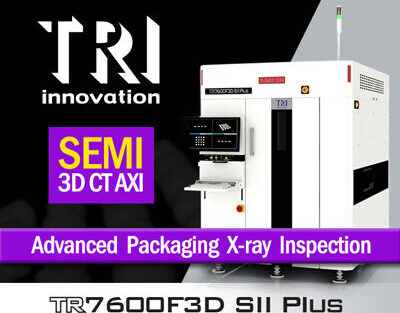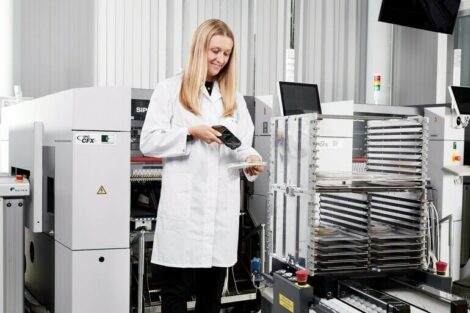MatriX Technologies was founded with the goal of becoming a leading vendor of automatic inspection systems for the electronics and automotive industries. In this interview, the company’s founder and manager, Eckhard Sperscheider, discusses to what extent that goal has been reached so far.
Where is Matrix Technologies (MXT) today?
In 2004, through a clear focus on automatic X-ray inspection (AXI) systems, Matrix Technologies laid the foundation stone for a new AXI system platform. We have already carried out expansive upgrades for clients with legacy NIS X-ray systems (3600/6000) to the new MIPS platform (MatriX Inspection & Process Software) over the last few months, and continue to do so. Now, we are focussing on the new AXI systems X2 & X2.5.
Following two years of extensive development, we are currently launching the new high-speed AXI series “X2”, which is being realized through beta-site installations in cooperation with key clients in the automotive sector. In that context, it is worth mentioning that in June 2006 Harman-Becker – the market leader for automotive navigation and audio systems – signed a global contract for inspection and process software with us. For MatriX that is of major strategic importance on the way to becoming a leading vendor in the AXI area.
In addition, since the beginning of 2006, we have a participation agreement with the Munich-based investment firm Extorel (Strascheg Holding) that underpins the further extension of our development capacity here at MatriX. And in June 2006, a loan programme for the development of new 3D X-ray procedures was approved by the Bavarian state government.
What are the company’s primary areas of focus?
AXI, which I already mentioned, are providing complete solutions for process analysis and active process control.
Key markets are electronics manufacturing in general and the automotive industry in particular. The range spans from SMT and semiconductor applications to classical ”non-destructive” testing (NDT), which increasingly works together with fully automated X-ray inspection systems. That includes, for example, the testing of airbag components and critical sensor elements for cars.
What do you see as being key trends, and where is there a need for action?
In the electronics industry, integration density and the miniaturisation of components continue to increase – influenced by that, the number of hidden solder-joints is increasing over-proportionally.
On the other hand, in manufacturing, assembly capacity – as a key factor for line throughput – is constantly being increased and necessitates higher inspection test speeds and resolutions.
In the wake of these technological and economic trends, an interesting effect can be observed in the investment cost area: the gap between comparable post-reflow AOI and AXI solutions is closing. Especially if the false calls rate – which is known to be higher for AOI – is taken into account, the gap is probably closed already.
Those factors are, in my opinion, to a large extent responsible for the fact that the demand for AXI solutions is currently on the rise again. That especially applies to high-quality products, for which 100% inspection is mandatory and therefore the norm in the automotive industry. For cars, electronics currently account for over 30 % of value creation, so increasing demand goes without saying – who wants to drive a car with components that haven’t been 100 %-tested?
For me, a further technological trend is the increasing demand for combination and integration of the various inspection and test points in an inspection line. Correlation for example: Solder defects that directly interfere with paste inspection at that particular point in order to determine the sources of possible process problems.
Of course, those are all measures for improving the general yield and quality goals. The real-time process control required to do so necessitates the integration of all the inspection points (which are usually from different manufacturers), as well as a common software platform that is as integrated as possible. That’s not a straightforward issue.
Where is there a need for action? …
The programming effort for developing and maintaining testing programmes, which is usually still too high, continues to be a critical issue in the inspection area. There is major potential for savings through the real-time and efficient use of the large amount of test results in closed feedback setups – by developing relevant software tools for those processes (active use of test results for improved analysis, defect library databases, etc.).
Here, whether the systems are optimally utilised, certainly plays a role. Physically you can’t test everything visually – especially solder joints. On the other hand, there are tests for which optical inspection is simply more efficient (especially at the component level).
Why is AXI and traceability important in the automotive industry?
End-to-end traceability has become a necessity in automotive manufacturing – largely due to the fact that possible product liability issues must be traceable. That has an especially major impact on the industry’s suppliers regarding their responsibility towards their clients.
In addition, the desired quality goals (zero defects, etc.) cannot be reached without a closed loop for the tracing of product defects and process parameters.
The importance of AXI for traceability lies, in my opinion, in the high-quality analysis and reporting capabilities of X-ray inspection. An X-ray image of a solder joint or component has a very high information and documentation value. As such, it is most valuable and primarily used for final verification. In addition, X-ray test results can deliver real quantitative measurement values of the solder-joint quality, which can even be used to analyse a process error that is only emerging. The superiority of AXI versus AOI and ICT X-ray techniques lies in that quality parameter potential.
Regarding the practical application of traceability for identification purposes – 1D/2D barcode and remote links to a possible central manufacturing computer must, of course, be realizable with AXI! For that, MXT offers flexible solutions with a range of standard scanners, as well as customised solutions.
Are only certain areas of the automotive industry affected?
Traceability is, generally speaking, a major issue throughout the automotive industry, as well as a number of other markets that need a guaranteed level of quality, e.g. high-quality telecommunications products, aerospace components and medical products.
Where does MXT see its role, and what might possible solutions look like?
Currently, almost 50 % of our software development budget is spent on AXI traceability, verification and process control. That we are able to offer our clients a complete inspection solution in the majority of cases shows how important that area is for us.
Under the umbrella term MIPS, automatic X-ray systems and software modules are offered for the following areas: firstly part identification and the verification of defective boards, including combined AXI, AOI and ICT repair software; secondly integration of all the inspection and testing points in a line and thirdly database management for test results, inspection parameters and quality rules, as well as test programme and version management
What are the strengths of the MXT-developed solutions?
The fact that we can supply complete inspection solutions is one of the key strengths of our portfolio.
Key components are the AXI system itself, with in-line or off-line configuration, a verification station, a repair station and an offline programming station. Important integral features are a number of CAD import converters, Q data export and – since 2006 – an inspection database that can also be cluster-configured as a client database.
Our goal for CAD import is 100 %-automatic integration of the relevant AXI data – enabling a program generation that is as automated as possible.
To realize such complete AXI solutions, it is necessary to ensure interfaces to clients’ existing software platforms and other inspection and test equipment. We offer a maximum of support in this area.
In particular, for the integration of alternative AOI test points with our process data system, we offer a large range of converters and links to a variety of well-known AOI systems.
Thank you for your time.
EPP Europe 401
Share:











